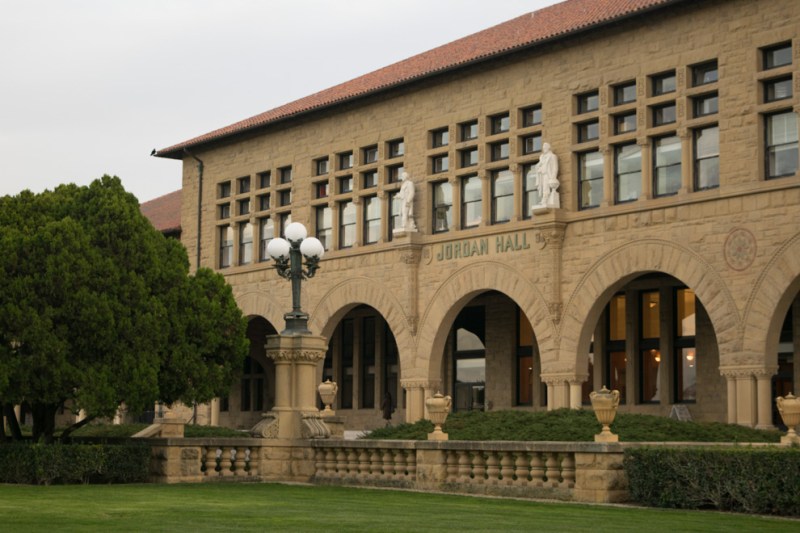Stanford will commission a committee to review requests submitted by the psychology department and the Stanford Eugenics History Project to rename Jordan Hall and remove a statue outside the building due to the namesakes’ ties to eugenics and polygenism, the University announced Monday.
Jordan Hall, which houses the psychology department, was named in 1917 for Stanford’s founding president David Starr Jordan. In addition to serving as a University president and a marine biologist, Jordan was a public leader of the American eugenics movement, promoting the belief that selective breeding based on genetic characteristics such as race can improve the human species. Jordan served as chair of the Eugenics Section of the American Breeders Association and was a member of the advisory council of the Eugenics Committee for the American Eugenics Society.
On Jan. 27, faculty members of the psychology department voted unanimously to request the renaming of the building and the removal of the statue of Louis Agassiz. Agassiz, who mentored Jordan but has no significant connection with the University, promoted polygenism, which posits the view that racial groups have distinct origins and are unequal.
“These features of our building have been a topic of concern within the Department for some time,” wrote Department Chair of Psychology and Lucie Stern Professor in the Social Sciences Anthony Wagner in a statement to The Daily. “In Fall 2019, the Department initiated a process to review Stanford’s and the Department’s values, to consider the nature of David Starr Jordan and Louis Agassiz’s specific behaviors, and to discuss what impacts these features of our environment are presently having on our community.”
In addition to considering the psychology department’s requests, the University is also reviewing a student group’s letter that urges the University to rename the building. The Stanford Eugenics History Project, a group founded by Ben Maldonado ’20 — who also writes the series “Eugenics on the Farm” for The Daily’s Opinions section — seeks to unveil historical ties between Stanford and the American eugenics movement.
“It is good to see the University start to confront its history with eugenics right now, during a historical moment when the rejection of eugenics and scientific racism is of vital importance,” Maldonado wrote to The Daily. “I think that the facts are very clear regarding Jordan’s role in the eugenics movement and I hope the committee will see that as grounds for renaming.”
According to the Stanford News announcement, Stanford President Marc Tessier-Lavigne said that he will “appoint a committee to review and report back on the two requests, following principles adopted in 2018 for considering the renaming of campus features named for historical figures with complex legacies.”
Tessier-Lavigne told the psychology department and the Stanford Eugenics History Project, however, that progress on the initiative will be on pause until the community returns to campus following the COVID-19 shelter-in-place.
“I will ask the committee to engage robustly with the campus community on issues raised in the requests, which will not be possible to do at a distance,” Tessier-Lavigne wrote in the Stanford News announcement.
The announcement also stated that during the review process, the committee would consider factors such as “the harmful impact of a person’s behavior, the centrality of the behavior to the person’s life as a whole, the person’s relation to university history, community identification with the named feature, the strength and clarity of the historical evidence, and possibilities for mitigation.”
These principles, which include both the “harm caused in retaining the name” and the “potential harms of renaming,” are outlined in a University document titled “Principles and Procedures for Renaming Buildings and Other Features at Stanford University,” and have guided past University renaming decisions.
In 2018, Stanford chose to rename some campus features that honored California missionary Father Junipero Serra — who has come under fire for his treatment of Native Americans — including Serra House, which is an all-frosh dorm in Stern Hall, and the building housing the Clayman Institute for Gender Research. Other features named for Serra, such as the Serra Street between Campus Drive East and El Camino Real, were retained.
Both groups involved in the renaming request expressed approval of the University’s announcement.
“We look forward to working with the committee appointed by President Tessier-Lavigne as they consider our request,” Wagner wrote.
“I knew the creation of the committee would be the next step, and I fully expect the committee to recognize Jordan’s harmful legacies,” Maldonado added.
However, students said, this is just one piece of the process.
“I hope that the committee will engage with the evidence we have documented judiciously and remember that this is about more than just a name — it is about critically engaging with the legacies of eugenics, especially in elite spaces like Stanford,” said Stanford Eugenics History Project member Linda Zhou ’22. “I believe, in light of the facts our project has presented, there is no excuse not to rename.”
“I also hope that, even before the committee and potential renaming, the University puts up some form of signage contextualizing Jordan’s life and actions, bringing attention to the way his widespread promotion of eugenics contributed to so much harm,” Maldonado wrote. “Of course, this all has to wait until campus life resumes, but I think an action like that would be a good first step.”
Contact Sarina Deb at sdeb7 ‘at’ stanford.edu.
